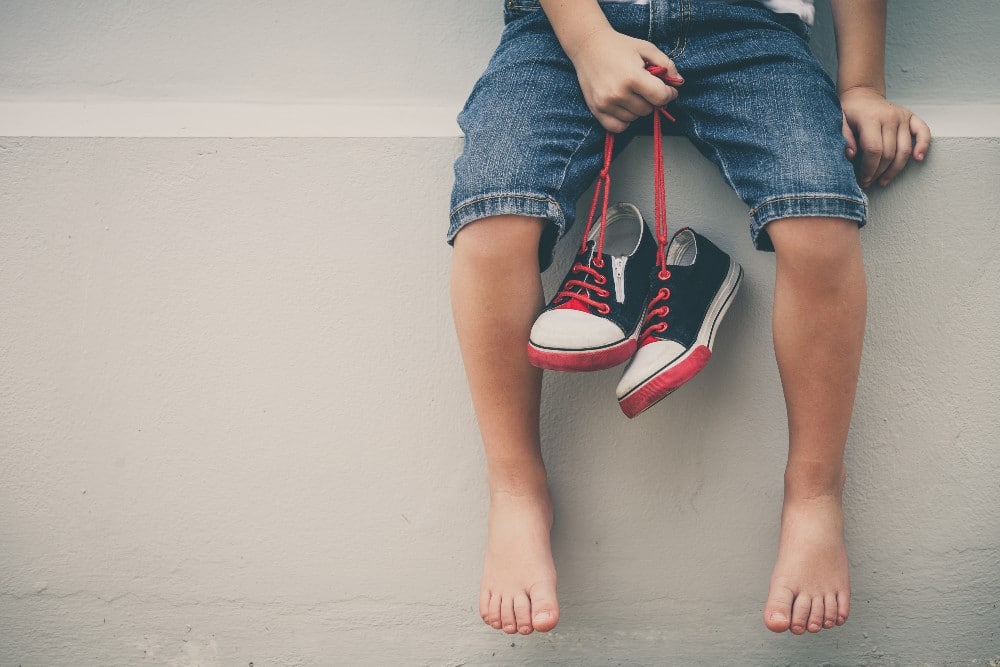Give Kids’ Feet the Back-to-School Protection They Need
There’s often lots to prep for when sending your child back to school. Health and safety are at the forefront of many parents’ minds more than ever before, but don’t forget about your child’s foot care when going through your mental checklist!
Back-to-school means more time spent in shoes and more time focusing on sports and activities for many kids. It is a great time to make sure your child’s feet are best prepared for the months ahead, and we have some tips to help you in the process.
Do Your Child’s Shoes Fit Properly?
Getting new back-to-school shoes might be in part to help your child look great at the start of the school year, but it’s also a great opportunity to ensure that footwear is keeping up with your child’s growth.
You might have already realized this, but young feet grow fast. While the rate of development may vary from child to child, general estimates place the rate of foot growth at a half-to-full shoe size every:
- 4-5 months for children ages 4 to 6
- 5-6 months for children ages 7 to 10
- 6 months for children ages 11 to 17
This typically means a need for bigger shoes 2-3 times each year, but sometimes that need can be as often as every season.
If your child is spending time in shoes that are too small and tight on them, it can easily cause pain, blisters, calluses, and ingrown toenails. Those can be huge distractions during a school day.
It’s helpful to keep a general schedule of when to look for new shoes. However, if you are already seeing signs that shoes may be too small (toe tips hitting the front of the shoes from inside, shoes bulging at the sides, your child complaining of discomfort and not wanting to wear the shoes, etc.), the time to get new ones is now.
Finding the Right Fit
What should you be looking for in a good pair of back-to-school shoes for your child?
First, the time of day you look can matter. Aim for later in the day, if possible. That is when our feet tend to be at their largest sizes thanks to gravity and moving around all day. Fitting a shoe to this larger size helps ensure comfort throughout the day.
Check each shoe candidate for the following:
- A stiff middle. When you grab each end of the shoe and twist, the middle should not collapse.
- Toe room. There should be about an index finger’s width between the tip of the longest toe and the front of the shoe.
- Toe flexibility. Bend the front of the shoe upward. It should give just a bit to allow for toe motion, but not easily fold in on itself.
- Heel firmness and slippage. Squeeze the heel of the shoe from both sides. It should not collapse. Also check that the heel of the shoe does not slide much against the back of your child’s foot as they walk.
And, never to be ignored, make sure your child feels comfortable and actually likes the shoes! You can hit all the marks above, but it’s still a loss if the shoes don’t feel good.
Gearing Up for Sports
If your child is starting up a new sports season this fall, then reducing their risk of foot and ankle sports injuries is always a good call.
An excellent first step toward protecting your child’s feet and ankles is making sure they have the right footwear and other equipment they need for the sport.
Kids who play organized sports should be wearing footwear that is specifically designed for that sport. These shoes are made to handle the unique demands and stresses of each sport – such as repetitive strikes or quick side-to-side movements – in ways that other shoes often aren’t.
Never assume that “every day” sneakers or shoes will provide the right type of support your child needs. Make sure your child is using the proper footwear, whether practicing or during a game.
Don’t Ignore Signs of Overuse Injuries
When starting up a new activity or increasing the intensity of a current activity, there can be a risk that the feet and ankles can be put through more than they’re currently conditioned to endure. This can lead to painful conditions such as Achilles tendinitis and Sever’s disease in children.
A child will not always directly tell you that they’re experiencing pain, often out of fear of treatment or of letting their team down. They might also simply expect the pain to be normal.
Knowing that, you should keep an eye out for any signs of injury in your child. These may include:
- Suddenly losing interest in the activities they used to enjoy, or wanting to end them earlier than usual.
- Limping or walking gingerly, especially during or after play.
- Not being able to keep up with friends during games or play.
- Frequently asking to be carried, if younger.
These examples are not an outright guarantee that your child is experiencing foot or ankle pain, they are a cue to ask them some questions and to continue observing for further signs of trouble.
Expert Children’s Foot Care Any Time of Year
Whether it’s school bells, jingle bells, or any other type of bells you may hear throughout the year, never hesitate to contact Southern California Foot and Ankle Specialists anytime you have questions or concerns about your child’s foot and ankle health. We can help you determine whether something is the matter, and – if there is – recommend a course of treatment to bring your child the quick relief and recovery they need.
Schedule an appointment with us by calling our Ladera Ranch office or by filling out our online contact form.

